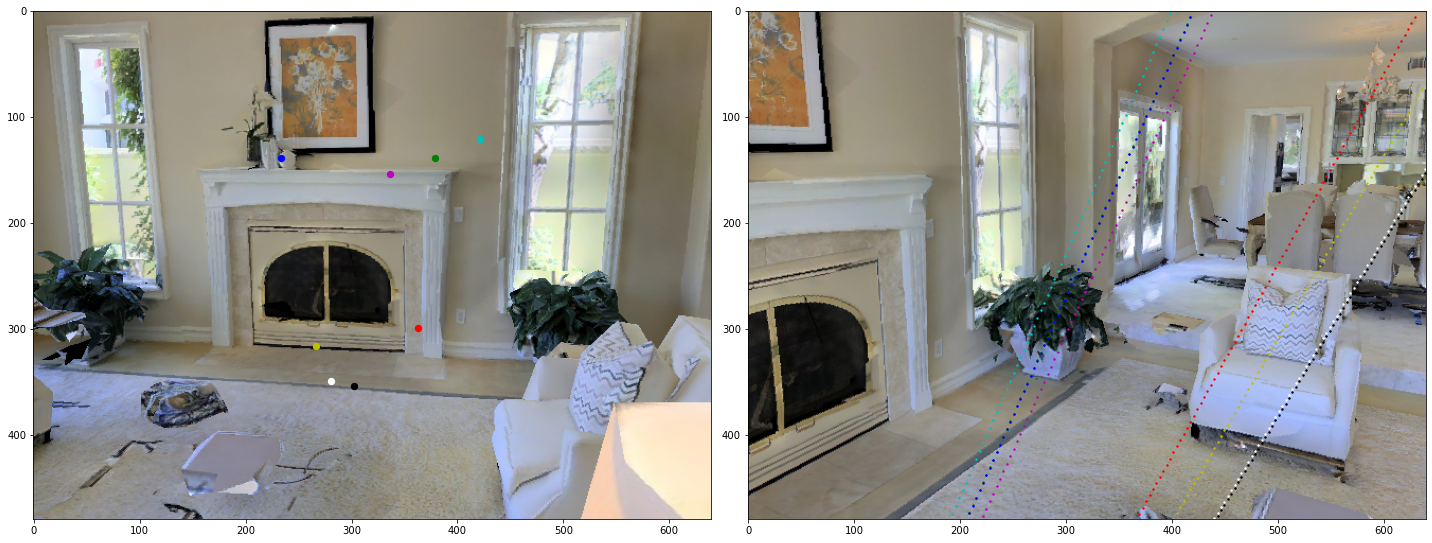crockwell / rel_pose Goto Github PK
View Code? Open in Web Editor NEW[3DV 2022] The 8-Point Algorithm as an Inductive Bias for Relative Pose Prediction by ViTs
License: BSD 3-Clause "New" or "Revised" License
[3DV 2022] The 8-Point Algorithm as an Inductive Bias for Relative Pose Prediction by ViTs
License: BSD 3-Clause "New" or "Revised" License
Hi @crockwell, this is a really cool work!
I am trying to generate the epipolar lines given the relative pose predicted by your model. However, I am not able to obtain correct epipolar lines -- my hunch is that I have misunderstood either the coordinate system (X,Y,Z axes) convention used by the model or maybe the rotation matrix is transposed?
This is what I am getting with my own script (which obviously looks wrong):

I was wondering if you can share the script you used to generate the epipolar line figures in the paper? That would be immensely helpful!
Thanks,
Yash
On skimming through the code it looks like it is 384 x 384, but in the supplemental paper it mentions it is 256 x 256.
Can you please confirm the input image size?
The given link for the pre-trained model is not responding:
https://fouheylab.eecs.umich.edu/~cnris/rel_pose/modelcheckpoints/pretrained_models.zip
Hello! Thanks for open-sourcing this amazing work! Here I have some questions about the paper.
Looking forward to your reply!
Hi,
thanks for the nice work.
I have one question regarding the depth scale in matterport. What I understood is that because matterport has rather larger translations than other datasets, the loss scale of translation error will be much bigger, which might affect negatively to the learning process.
That's why in here:
rel_pose/src/data_readers/matterport.py
Line 48 in 35d1352
you divided by 5 to adjust the scale?
If this is right, then my other question is, don't we have to change the intrinsics similarly?
Thanks!
Thank you for the interesting work. I just had a quick question regarding Equation 2 of the paper:

Previously, it is explained that
Hi, thanks for sharing your work, really appreciate it! I have some questions about intrinsic parameters. Is the camera intrinsic parameters necessary to this algorithm? Can this algorithm work without intrinsic and extrinsic camera parameters? How is the performance (with and without intrinsic parameters)? Because I might have some dataset and want to test, but I have no idea about the intrinsic and extrinsic camera parameters.
Thank you very much!
Was there a speicfic reason to not evalaute on 7scenes and the cambridge dataset as they are often used in related works?
Enjoyed reading your paper. Nice work!
Nevertheless, I had a doubt as I went through the code and noticed the hyper parameter cross_features which I think governs equation 2's V_i, whether it is V_i.T A V_i or V_j.T A V_i. It looks to me when self.cross_features is False, the Essential Matrix module does not really capture the matrix U⊤U. Correct? If so, why would self.cross_features=False still be helpful?
Thank you.
A declarative, efficient, and flexible JavaScript library for building user interfaces.
🖖 Vue.js is a progressive, incrementally-adoptable JavaScript framework for building UI on the web.
TypeScript is a superset of JavaScript that compiles to clean JavaScript output.
An Open Source Machine Learning Framework for Everyone
The Web framework for perfectionists with deadlines.
A PHP framework for web artisans
Bring data to life with SVG, Canvas and HTML. 📊📈🎉
JavaScript (JS) is a lightweight interpreted programming language with first-class functions.
Some thing interesting about web. New door for the world.
A server is a program made to process requests and deliver data to clients.
Machine learning is a way of modeling and interpreting data that allows a piece of software to respond intelligently.
Some thing interesting about visualization, use data art
Some thing interesting about game, make everyone happy.
We are working to build community through open source technology. NB: members must have two-factor auth.
Open source projects and samples from Microsoft.
Google ❤️ Open Source for everyone.
Alibaba Open Source for everyone
Data-Driven Documents codes.
China tencent open source team.